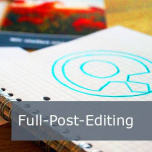
Checklist: Full Post-Editing
Service


Information
Do you want to integrate post-editing into your translation process but are still unsure which strategy fits your processes best? Would light or full post-editing make the most sense for you? What steps are necessary and which are just "nice to have"?
With this checklist, we want to support you in your decision and provide practical assistance.
Full Post-Editing:
• Purpose of the text: Texts with high visibility; texts to do with liability; content where emotion should be conveyed as well as information
• Goal: Machine translation that is qualitatively similar or equivalent to a human translation
• Result: The aim of full post-editing is to ensure that the target text is presented in a way that is understandable to and both accurate and linguistically correct for the reader. Stylistic adjustments are made where necessary - the style cannot match the quality of a native speaker or human translator, but in this case the syntax corresponds to the usual form. Grammar and punctuation are used correctly.
How to ensure successful full post-editing:
• Ensure no information has been added or omitted
• Edit offensive, inappropriate or culturally unacceptable content
• Restructure incorrect or unclear sentences
• Ensure grammatical, syntactical and semantical correctness of thse translation
• Ensure correct spelling, punctuation and hyphenation
• Follow formatting rules
• Adhere to client/domain terminology (ensure that terms on the client’s list of “Do Not Translate” terms are not translated)
• Ensure that the style is appropriate for the text type
• Ensure that the client’s stylistic guidelines are observed
Language
GermanEnglish
Category
Localization and Translation
Type
Service
Exhibitor
tsd Technik-Sprachendienst GmbH
